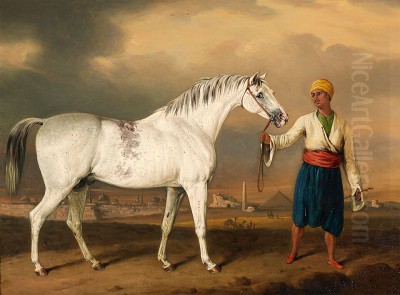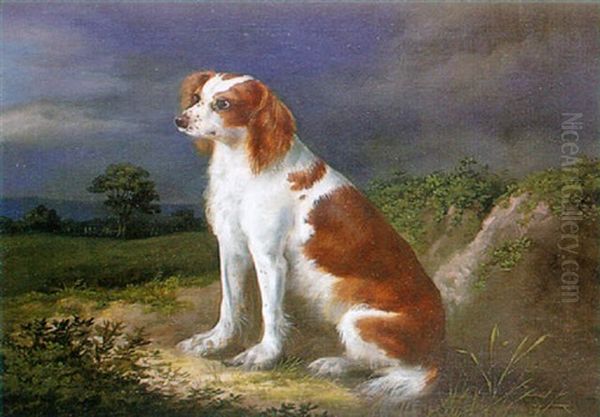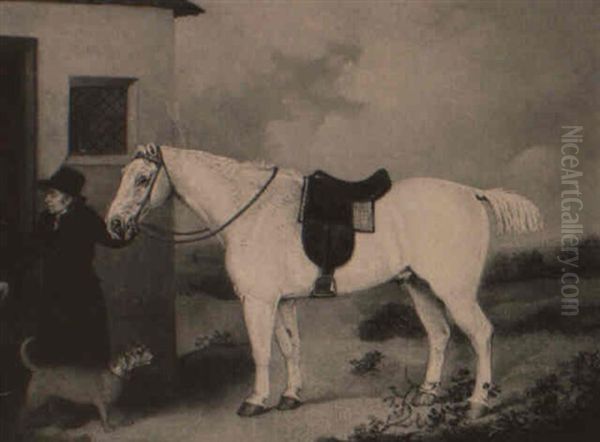
Henry Bernard Chalon stands as a significant figure in the annals of British art, particularly renowned for his exceptional skill in depicting animals. Active during the late Georgian and Regency periods, his life and work offer a fascinating glimpse into the artistic tastes and social milieu of his time. Born into an era where sporting art and animal portraiture were highly valued by the aristocracy and gentry, Chalon carved a distinct niche for himself, leaving behind a legacy of finely executed paintings and prints that continue to be admired today.
Dutch Roots and Early Life in London
Henry Bernard Chalon was born in London in 1770, although his family origins lay in the Netherlands. He was the son of Jan Chalon, a Dutch immigrant who had established himself in London as both a music teacher and a talented engraver. This artistic lineage undoubtedly played a role in shaping young Henry's future path. Growing up in a household where artistic skill, particularly in engraving, was practiced and presumably valued, likely provided him with early exposure and encouragement.
The family had relocated to London just a year after Henry's birth, in 1771. London, at this time, was a burgeoning metropolis and a vibrant centre for the arts, offering numerous opportunities for aspiring artists. While specific details about his formal training remain somewhat scarce, it is clear that he developed his talents considerably, likely benefiting from his father's guidance in the techniques of drawing and engraving, which formed a solid foundation for his later work in painting.
The Rise of an Animal Painter
Chalon quickly distinguished himself with his remarkable ability to capture the likeness, spirit, and anatomical accuracy of animals. His primary focus became the depiction of horses and dogs, subjects that held immense appeal for the British upper classes, whose lives often revolved around hunting, racing, and breeding. He worked proficiently in oil paints, creating detailed canvases, but was also skilled in drawing and various printmaking techniques, including lithography and etching.

His style was characterized by a commitment to realism, combined with a sensitivity to the individual character of his animal subjects. He possessed a keen eye for detail, meticulously rendering the texture of fur, the musculature beneath the skin, and the expressive quality of an animal's gaze. Unlike some contemporaries who might have romanticized their subjects, Chalon often aimed for a faithful representation, grounded in careful observation.
Specialization in Equine and Canine Art
Horses were a recurring and central theme in Chalon's oeuvre. He painted famous racehorses, cherished hunters, and elegant carriage horses, often commissioned by their proud owners. His understanding of equine anatomy was profound, allowing him to depict horses in various poses and states of action – standing proudly, galloping across a field, or even showing the strain of exertion. His works serve not only as artistic achievements but also as valuable historical records of specific animals and breeds popular during his time.
Dogs were another favoured subject. He painted various breeds, often capturing them in relaxed domestic settings or as active participants in sporting scenes. His depictions of spaniels, setters, hounds, and terriers showcase his versatility and his ability to convey the distinct characteristics and temperaments of different types of dogs. These canine portraits were often imbued with a sense of warmth and personality, reflecting the growing status of dogs as companions within affluent households.
Notable Works and Artistic Signature
Several works stand out as representative of Henry Bernard Chalon's skill and typical subject matter. His painting Man on Horseback, Leading a Horse and a Dog, dated 1796, is an excellent example of his early mastery. It showcases his ability to compose a scene involving multiple figures – human and animal – and to capture the textures of coats, tack, and landscape with precision. The interaction between the figures suggests a narrative, likely related to travel or sport.
Another significant area of his work involved studies, such as his Studies of Horses. These works, often sketches or less formal paintings, reveal his process of observation and his dedication to understanding the form and movement of his primary subject. Similarly, his Outline of Wounded Horses With Their Muscles in Action at the Battle Field demonstrates a deeper, almost scientific interest in equine anatomy under duress, moving beyond simple portraiture into anatomical study, perhaps influenced by the work of earlier masters like George Stubbs.

His depictions of specific breeds, like the Blenheim Spaniels shown in a landscape setting, highlight his ability to integrate animal subjects seamlessly into their environment. One such painting, featuring four spaniels near a tree with a flintlock gun resting nearby, not only captures the charm of the breed but also evokes the atmosphere of a country estate and its associated pursuits. The reported sale of a spaniel painting for £7,400, significantly exceeding its estimate, attests to the enduring appeal and market value of his work. The piece titled Rake, a white and tan spaniel, further exemplifies his focus on individual animal portraiture.
Royal and Aristocratic Patronage
A significant measure of Chalon's success was the prestigious patronage he attracted. He was appointed 'Animal Painter' to Frederica Charlotte, the Duchess of York and Albany. The Duchess was known for her love of animals, particularly dogs, and her patronage would have provided Chalon with valuable commissions and enhanced his reputation within elite circles. This appointment underscored his position as one of the leading animal painters of his day.
Later in his career, Chalon received further royal recognition when he was appointed Animal Painter to King William IV. Serving two members of the royal family in this capacity was a considerable honour and cemented his status. Beyond royalty, his work was sought after by prominent families, including the Rumbold banking family, whose collection included works by Chalon that were passed down through generations. Such patronage was crucial for an artist's livelihood and visibility in the 18th and 19th centuries.
Chalon as a Printmaker
Beyond his paintings, Henry Bernard Chalon was an accomplished printmaker. This skill likely stemmed from his father's profession as an engraver. Chalon produced etchings and lithographs, often based on his own paintings or drawings. Printmaking allowed his work to reach a wider audience than unique oil paintings could, and prints of sporting subjects and animals were highly popular during this period.
His technical proficiency in printmaking is evident in his surviving works. He sometimes collaborated with other leading printmakers of the day. A notable example is his collaboration with the renowned mezzotint engraver William Ward. Together, they produced an etching depicting 'Thunder', described as an old English Setter belonging to a Mr. Robert Jones. This collaboration highlights the interconnectedness of the London art world, where painters and engravers often worked together to disseminate images. William Ward, along with his brother James Ward, who was also a painter and engraver, were significant figures in the printmaking scene.
The Chalon Artistic Family
Henry Bernard Chalon was not the only artist in his immediate family. His father, Jan Chalon, was an engraver, establishing an artistic precedent. Furthermore, his brother, Alfred Edward Chalon (1780–1860), became an even more famous artist, though in a different field. Alfred Edward specialized in portraiture, particularly watercolour miniatures, and became a favourite of Queen Victoria, who appointed him Painter in Water Colours to the Queen. He was elected a full member of the Royal Academy (RA).
While Henry Bernard focused on animals and sporting art, Alfred Edward excelled in capturing the elegance and fashion of high society figures. The presence of two successful artists in the same generation of the Chalon family speaks to a strong creative current within the household. Though their specializations differed, they were contemporaries navigating the same London art scene, likely supporting and perhaps influencing each other in subtle ways.
Context within British Art: Contemporaries and Influences
Henry Bernard Chalon worked during a golden age for British animal and sporting art. His career overlapped with several giants in the field. George Stubbs (1724-1806), arguably the most celebrated British animal painter, known for his anatomical precision and classical compositions, set a high standard. While Chalon's work may not possess the same monumental quality as Stubbs's best pieces, his dedication to anatomical accuracy certainly echoes Stubbs's influence.
Other notable contemporaries specializing in similar subjects included Sawrey Gilpin (1733-1807), known for his spirited depictions of horses, often in dramatic or romantic settings, and Ben Marshall (1768-1835), who brought a new level of realism and character to racehorse portraiture. James Ward (1769-1859), brother of William Ward, was another versatile artist excelling in animal painting, landscapes, and large-scale allegorical works, sometimes seen as a rival to Stubbs. Chalon's work fits comfortably within this tradition, offering his own distinct blend of careful observation and sensitivity.
Beyond animal specialists, Chalon's era saw the flourishing of British landscape painting with masters like J.M.W. Turner (1775-1851) and John Constable (1776-1837), who revolutionized the genre. While Chalon's focus remained primarily on the animals, his landscape backgrounds show an awareness of contemporary conventions. Portraiture also thrived, with leading figures like Sir Thomas Lawrence (1769-1830), Sir Henry Raeburn (1756-1823), and George Romney (1734-1802) dominating the field – the same field where Chalon's brother Alfred Edward would later make his mark. Printmaking was also vibrant, with figures like Thomas Bewick (1753-1828) revolutionizing wood engraving, alongside mezzotint specialists like William Ward. Chalon operated within this rich and diverse artistic ecosystem.
Later Life and Legacy
Henry Bernard Chalon continued to work throughout the early decades of the 19th century, adapting perhaps to changing tastes while maintaining his core focus on animal subjects. He lived through a period of significant social and artistic change in Britain. He passed away in London in 1849, having lived a long life dedicated to his art.
His legacy endures primarily through his contribution to the genre of animal painting. His works are valued for their technical skill, their faithful representation of specific animals (important for breed histories), and their evocation of the sporting life of Georgian and Regency England. They provide a window into the interests and aesthetics of his patrons and the era itself.
Today, works by Henry Bernard Chalon can be found in various public and private collections. Institutions like the Yale Center for British Art hold examples of his work, recognizing his place within the broader narrative of British art. His paintings and prints continue to appear at auction, often commanding respectable prices, demonstrating a sustained interest among collectors of sporting art and animal portraiture. He remains an important figure for understanding the development and popularity of animal painting in Britain.
Conclusion: An Enduring Appeal
Henry Bernard Chalon navigated the competitive London art world of the late 18th and early 19th centuries to become a respected and sought-after specialist in animal art. Born into an artistic family of Dutch origin, he leveraged his talent for detailed observation and skilled execution to capture the horses and dogs so beloved by his patrons, including members of the British royal family. His work, encompassing oils, drawings, and prints, stands as a testament to his dedication and skill. Situated alongside contemporaries like Stubbs, Marshall, and the Ward brothers, Chalon made a distinct contribution to a genre that vividly reflects the culture and passions of his time. His art continues to engage viewers with its blend of realism, character, and historical insight.